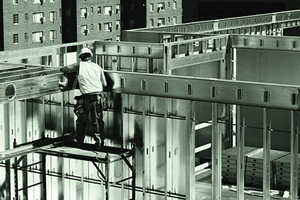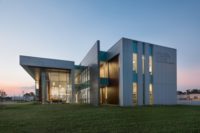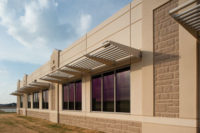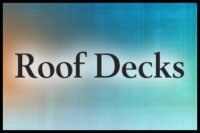The use of green building materials and products has become an important strategy in the design of today’s new buildings. Whether you are an architect, builder or contractor, customers are increasingly requesting high-performance building materials that contribute to sustainable, healthy and comfortable interior environments.
or contractor, customers are increasingly requesting high-performance building materials that contribute to sustainable, healthy and comfortable interior environments.
One of the key elements to a more sustainable building is a durable, well-designed building envelope. Though wood framing is the traditional choice, many building and design professionals are turning to cold-formed steel framing components to construct a more sustainable, high-performance wall assembly.
SUSTAINABLE FEATURES
Not only is steel good for the environment, but its natural properties are also beneficial to the overall structure once installed. For example, steel is very durable and noncombustible, and therefore is longer lasting and will not contribute to the spread of fire. Additionally, as an inorganic material, steel will not rot, crack, warp or split.
Steel is also resistant to mold growth, and does not attract termites and other wood-boring insects. Furthermore, moisture will not seep into steel studs, which substantially eliminates the expansion and contraction of construction materials around doors and windows where leaks can occur. And, because steel studs are dimensionally stable, they ensure that buildings will have straight walls and square corners, thereby eliminating aggravating nail pops and unsightly drywall cracks.
In addition to the environmental benefits, building and design professionals are also turning to steel framing because it offers:
-
High-strength results in safer structures, lower maintenance and slower aging of structure
-
Fire safety
-
Decreased potential for foundation problems—less weight results in less movement
-
Lower potential for damage in the event of an earthquake—lighter structure with engineered connections results in better seismic performance
-
Stronger connection to drywall, as materials are screwed versus nailed to wood framing
ACOUSTIC CONTROL
Steel framing and other wall assembly components can also be employed to enhance the acoustical performance of the building envelope. Manufactured from 25-gauge steel, resilient furring channels are a cost-effective option to control sound from room to room. The channel functions as a de-coupler (i.e., a means for attaching gypsum board to the studs without actually allowing the board to touch them). This separation of the gypsum board from the studs impedes the transmission of airborne sound waves through the wall assembly by breaking their path.
Research indicates that when combined with standard batt insulation, resilient channels can add up to 5 sound transmission class points to an otherwise identical wall. This can often be enough to meet the STC ratings required by the project design goals or local codes. This is especially important for multi-family dwellings that occupy a number of residents.
THE USE OF STEEL ON THE JOB SITE
The use of steel framing products can help minimize jobsite waste, as its inherent product uniformity means less material is left after construction, especially when the steel framing members are pre-cut to length by the manufacturer. Moreover, the nearest scrap metal processor can easily recycle any remaining material.
Speed and accuracy are critical in all projects, and working with steel framing is one of the many ways to streamline the construction process. The high strength-to-weight ratio of steel allows framing members to be lightweight, which results in easier handling and installation, and ultimately time efficiencies in the construction cycle. In addition, transportation expenses and fuel consumption are reduced, as steel studs are fabricated locally or formed into desired shapes on the job site.
Additional benefits to the builder include:
-
Substantial discounts on builder’s risk insurance
-
Easy material selection—no need to cull or sort the pile
-
Saves job site time with ease of panelization off-site
-
Windows and doors open and close as they should
-
Less scrap and waste (2 percent for steel vs. 20 percent for wood)
-
Price stability—price spikes are extremely rare
The long spanning capability of steel also enables the creation of large areas of unobstructed space in multi-story buildings. Fewer columns make it easier to subdivide and customize living and office space for current and future tenants. Open space also is more attractive to speculative buyers and commands a premium price in a competitive market.
STEEL IN RETROFIT PROJECTS
Modifications of an existing space, such as the addition of a new staircase, elevator or column-free space, or the raising or lowering of a ceiling, can be a challenge with traditional framing materials. However, the difficulty is significantly reduced with steel framing.
The high strength-to-weight ratio of steel enables it to span large distances economically and without sacrificing structural safety. The strength of steel provides clear span, or column-free areas that offer greater flexibility of floor layouts. Building owners will have the freedom to subdivide and customize space or opt for light steel partition walls that can easily be relocated, leading to adaptable buildings with the ability to meet current and future needs.
WHY COLD-FORMED STEEL FRAMING?
There are many reasons why steel framing has come to the forefront as one of the best and most practical alternative building materials for residential and commercial construction. Steel contains at least 25 percent recycled content and is 100 percent recyclable. Recycling saves energy and other natural resources as embodied energy is amortized over future generations of new steel. As a recognized green building material, steel framing projects are eligible to earn certification in the U.S. Green Building Council’s Leadership in Energy and Environmental Design programs and other green building programs.
CONCLUSION
The sustainable qualities of cold-formed steel framing when used in wall assemblies make it a natural fit for high-performance building envelopes. Its many properties can help create a more comfortable interior environment for building occupants, and steel is inherently durable and virtually maintenance-free. In addition, the many environmental and economical benefits of steel framing construction provide savings in time and money, an important consideration in the current economy. Using steel and other sustainable building materials also helps building owners reduce their environmental footprint. All of these features make steel framing an all-around beneficial choice for both commercial and multi-family building projects.



